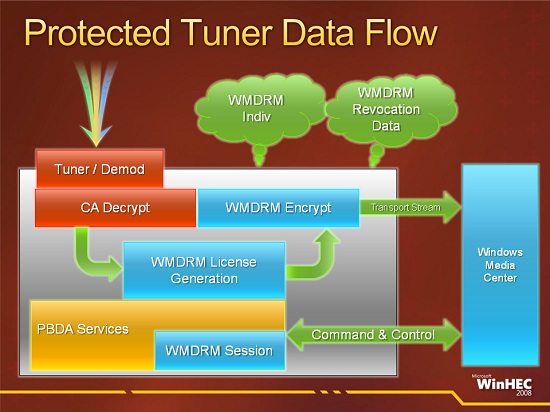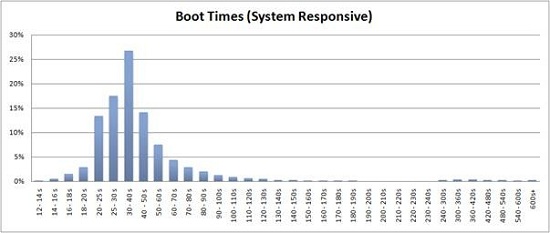Windows 7: Release Candidate 1 Preview
by Ryan Smith and Gary Key on May 5, 2009 11:00 PM EST- Posted in
- Systems
Getting Dirty: What’s Changing Under the Hood
While Windows 7 is a refinement of Vista, this doesn’t preclude making some changes in the kernel and other related systems. Microsoft has opted to spend most of their efforts working on various graphics systems, so among the big changes there’s only a few items of note that don’t fall into the graphics category.
Likely the change with the most immediate impact is that Microsoft has reworked the subsystem responsible for TV tuners, the Broadcast Driver Architecture (BDA). The latest incarnation of BDA adds a full DRM chain, giving rise to the Protected Broadcast Driver Architecture (PBDA). PBDA solves the biggest issue Microsoft has had getting Windows computers accepted as TV viewers: the lack of a simple and effective DRM chain between the tuner and the computer. HDCP ensures that content is protected between the computer and the display, but there has been no standardized way to do the same with incoming content. As such the only services that allow Windows connectivity with protected content thus far have been cable systems using CableCARDs, all the while limiting this functionality to computers specially licensed by CableLabs.

PBDA protected data flow. Slide courtesy Microsoft
PBDA also resolves some lesser technical issues with BDA, such as how a device should communicate with Windows Media Center when it needs setup information that Windows Media Center can’t provide, and how to feed guide data to Windows Media Center (currently it pulls the data from Zap2It). Although this is open to all services, Microsoft’s primary example here is DirecTV, which would require all of these additions. DirecTV has been developing the HDPC-20 tuner for PCs but held it back for unnamed reasons. All indications are that the HDPC-20 will finally be a go due to PBDA (and the addition of H.264 decoding support helps, too).
The downside from all of this however is obvious: more DRM. We’re not fans of DRM, so we’re not enthused to see that yet more DRM is required before content distributors are willing to let Windows computers access their content. It’s very much making a deal with the Devil.
Next up, the Windows kernel has also seen some tweaking in preparation for ever-larger core counts on CPUs. Vista was tuned for up to 32 cores, but the dispatcher lock made scaling beyond that difficult as it causes threads to spend too much time waiting on the lock. The lock has been redesigned to better support more cores, pushing the new cap up to 256 cores. Bear in mind that currently a single Intel Nehalem quad-core processor effectively has eight cores due to Hyper-Threading, so it was possible to hit the 32 core limit on a 4P Nehalem system, directly creating a problem once Intel puts more cores into Nehalem’s successor. With the limit raised to 256 cores, Windows 7 should be well ahead of the CPUs again.
SSD users will be happy to know that Windows 7 has improved support for those devices. Although Windows 7 doesn’t have an SSD-optimized file system as first rumored, it is adding TRIM support. For more details on TRIM, please see our SSD Anthology article
Wrapping up the changes, Microsoft has also added native support for Wireless Wide Area Networks (WWAN), more commonly referred to as mobile broadband networks. Adapters for such networks were already usable on existing Vista and XP installations, but this brings the configuration of those devices into the OS rather than using 3rd party utilities, similar to how Windows took over WiFi management previously.
Further optimizations have also been made under the hood to help contain Windows’ resource usage and speed up its boot time. Microsoft hasn’t documented every single change they’ve made to make Windows less resource hungry, but there’s clearly a cumulative effort beyond just squeezing more out of the DWM and gadgets (more on this later). Meanwhile everything that makes Windows less resource hungry feeds into shaving seconds off how long it takes to boot Windows, which along with other changes is designed to help get Windows to consistently boot in under 30 seconds. Changes here include additional parallelism in driver initialization and chopping down the number of services that load with the system before they’re ever called. SuperFetch has also been slightly tweaked to improve the post-boot experience – it no longer starts caching things immediately after the user account loads, so that using a freshly booted computer isn’t quite so sluggish. In effect SuperFetch has been deprioritized some so that its loading is less noticeable to the user.

Vista SP1 Boot Times, Courtesy Microsoft










121 Comments
View All Comments
Adul - Wednesday, May 6, 2009 - link
MS cash reserves are actually around $26.3 billionsnookie - Wednesday, May 6, 2009 - link
Apple's stock is dramatically higher and they have much more cash in reserve. Xbox sure in hell was designed to be profitable on both hardware and games and neither is. Microsoft knew they would lose money the 1st few years but nothing like this. It's been a total disaster for them financially.Investors are bullish on Microsoft? Well a lot of them aren't. Microsoft lost half its value in 2008. Half.
Q9 has not been dismal for Apple. Biggest 2nd quarter ever in the middle of a recession. i guess that must be because of their commercials though....new iPhone coming up in June which will sell as fast as they can make them and Microsoft can't even get that blind, crippled, and dumb Windows Mobile out the door. This is a company in dire need of new leadership and middle management. Instead their answer is to rant and rave and piecemeal out development to whichever country is cheaper this week? Sound like a long term formula to success to you?
chewietobbacca - Thursday, May 7, 2009 - link
You're kidding right? Apple's stock is higher but their market cap is worth $60 billion less because share prices don't mean sh!t. Apple has fewer shares out there hence each one is worth more, but MSFT is still worth 60billion more than AAPL, and if MSFT goes up to $24 a share again, it'll be worth even more.Patrick Wolf - Wednesday, May 6, 2009 - link
Psycho...Jjoshua2 - Wednesday, May 6, 2009 - link
That's good to see its performance is good in general, and its gaming is consistently higher as well. Posting from Windows 7 on my Wind Netbook FTW :)Any pricing news? I hope there's a great student rate.
griffhamlin - Wednesday, July 15, 2009 - link
"gaming perfs constistently higher" ???are you kidding ? the song remain the same ...
samspqr - Wednesday, May 6, 2009 - link
the main reason I hate vista is because it's not XP: everything looks different, I can never find what I'm looking for, so getting used to it would require an effort that doesn't seem to have any compensating advantages (I don't like fancy UIs -I still use the W2K look- and I don't really play games anymore)then, about windows7, I still feel it's just a re-spun new SP for vista, with a UI revision, and the only reason it's getting better reviews than the original vista is that some time has passed, so there are better drivers, and you're testing it on much more powerful hardware
now, that Wind comment makes me wonder...
may even I fall on this one?
we'll see
cyriene - Wednesday, May 6, 2009 - link
I never understood how XP users say they "can never find anything in Vista."I'm not Windows expert, but after using my new laptop with Vista for 3 hours I knew where over 95% of the things and setting are located. And mos tof them are in the same place as XP for that matter. Control panel is the same... Start menu slightly different, but similar enough to figure out in 5 seconds. Plus if there is something you're looking for, the Vista help search actually ...HELPED me find it! I was actually suprised how well the help works. Also, if that failed a quick Google search is all it takes.
I don't feel MS should make ever OS exactly the same with everything in the same place. It makes sense for some things to move, and it isn't hard to find them if you take 5 seconds to do that.
dmpk - Saturday, May 30, 2009 - link
I agree. I think it is easy to find stuff on Vista with a little bit of playing. The transition is same as that from Windows 98 to Windows XP...piroroadkill - Thursday, May 7, 2009 - link
I completely agree. If you can't find something in Vista and you're used to XP, it's either so unused that it was removed, or you're just not trying, at all.